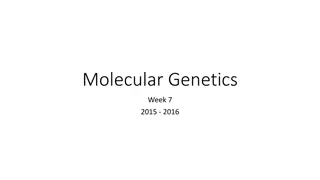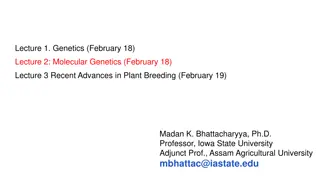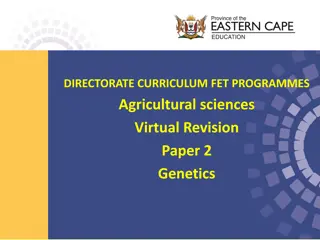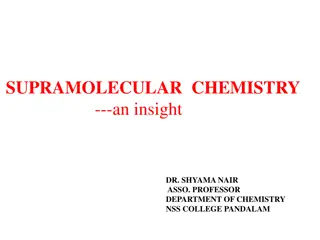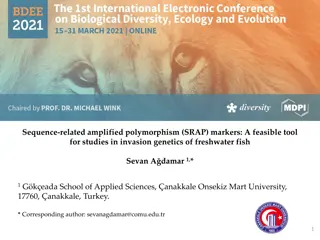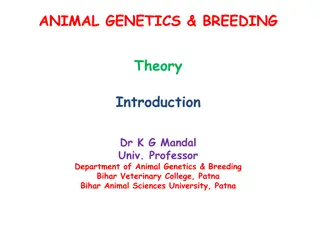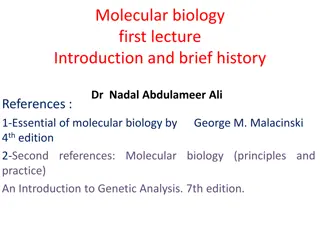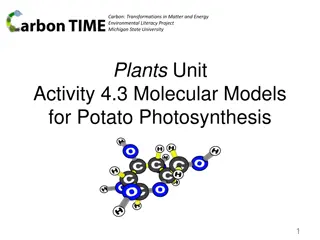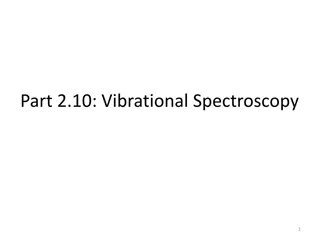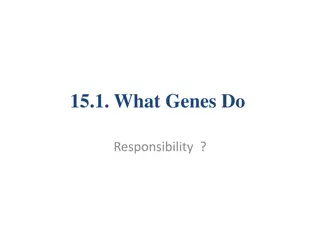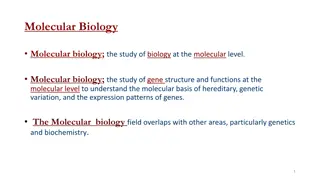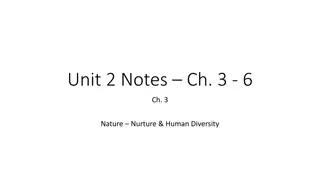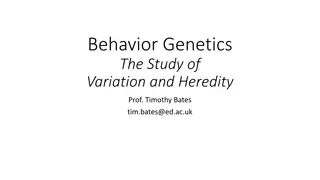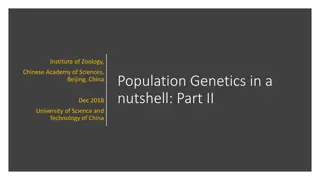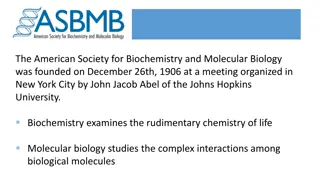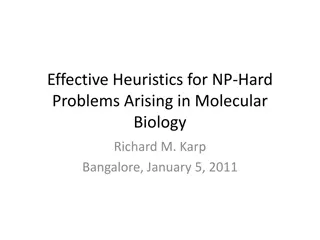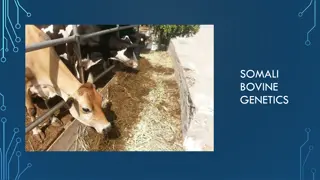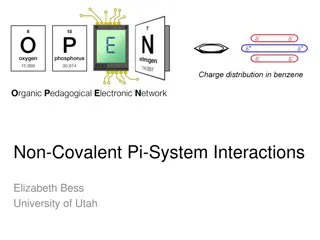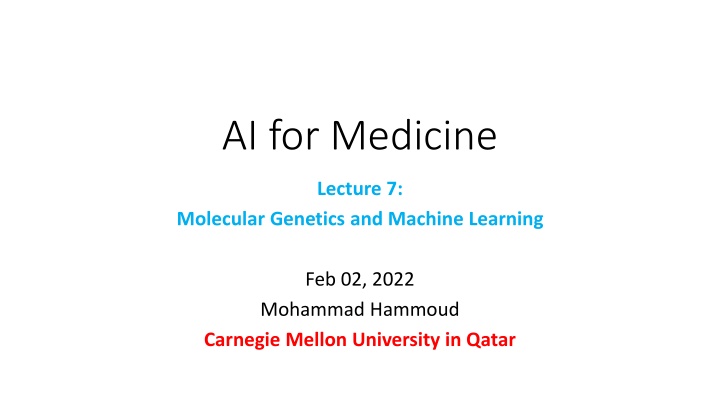
Molecular Genetics and Machine Learning in Molecular Medicine
Explore the intersection of molecular genetics and machine learning in molecular medicine, as demonstrated by Stormo et al.'s utilization of an ML algorithm to distinguish ribosome binding sites from non-sites through representation and training processes. Understand the complexity of identifying optimal binding sites and the importance of features beyond sequence similarity.
Download Presentation

Please find below an Image/Link to download the presentation.
The content on the website is provided AS IS for your information and personal use only. It may not be sold, licensed, or shared on other websites without obtaining consent from the author. If you encounter any issues during the download, it is possible that the publisher has removed the file from their server.
You are allowed to download the files provided on this website for personal or commercial use, subject to the condition that they are used lawfully. All files are the property of their respective owners.
The content on the website is provided AS IS for your information and personal use only. It may not be sold, licensed, or shared on other websites without obtaining consent from the author.
E N D
Presentation Transcript
AI for Medicine Lecture 7: Molecular Genetics and Machine Learning Feb 02, 2022 Mohammad Hammoud Carnegie Mellon University in Qatar
Today Last Wednesday s Session: Molecular genetics and machine learning Today s Session: Molecular genetics and machine learning (conclude)
Back to Where We Started While it is easy to find a consensus sequence that identifies existing binding sites, it is not easy to find one that is optimal for predicting the occurrence of new sites Stormo, Gary D., et al. [3] discovered that some published binding sites identified by consensus sequences did not function as translation initiation sites in mRNA of E.coli This lead to the hypothesis that there could be features (beyond only similarity between sequences) that can serve in distinguishing true ribosome binding sites from non-sites In an attempt to learn these features and distinguish between true-sites and non-sites , Stormo, Gary D., et al. used an ML algorithm named perceptron!
From Abstraction Abstraction to Representation Representation To this end, they used a training dataset that contains 78,612 bases of transcribed RNA on which reside (at least) 124 genes The first question was, how to represent any given sequence (say, a seven long sequence ACGGTAC)? They used a matrix of 4 x N elements, where N is the length of the sequence, and 0s and 1s to indicate the absence or presence of a base at any position 1 2 3 4 5 6 7 A 1 0 0 0 0 1 0 C 0 1 0 0 0 0 1 Represents ACGGTAC G 0 0 1 1 0 0 0 T 0 0 0 0 1 0 0
From Representation Representation to Training Training They then: trained a perceptron using the given training set, and once done, examined any new sequence and inferredwhether it is a true-site or non-site For this sake, they needed to associate a weight with each xij in any input feature matrix x (hence, they defined matrix w) and a threshold ? such that the (simplified) output is: +1 if a defined score over w.x> ? The special case where the score is ?will be regarded as wrong -1 if a defined score over w.x < ?
From Representation Representation to Training Training They then: trained a perceptron using the given training set, and once done, examined any new sequence and inferredwhether it is a true-site or non-site Note: Be careful about the dimensions of the matrices: E.g., if x is 4 6, then w should be 4 4 Consequently, the output of w.x will be 4 6 You can then compute the score on the output of w.x Then compare the score against ? If the result is a misclassification, you can replace w by w + ?.x.y after transforming y into a matrix with dimension 6 4
Recall: Scores Over Position Weight Matrices A score over a weighted matrix representation can be calculated as follows: One column for each position in the Pribnow sequences This matrix is the result of w.x A -38 19 1 12 10 -48 One row for each nucleotide C -15 -38 -8 -10 -3 -32 G -13 -48 -6 -7 -10 -48 T 17 -32 8 -9 -6 19 Score of TATAAT = 17 + 19 + 8 + 12 + 10 + 19 = 85
Training Perceptron algorithm: 1. Assume ? is 0 and initialize the weight vector, w, to random numbers 2. Pick a learning-rate, ?, that is a small, positive real number Note: The choice of ? affects the convergence of the perceptron. If ? is too small, convergence is slow; if it is too big, the decision boundary will dance around and again will converge slowly, if at all 3. Consider each training example t = (x, y) in turn: a. Let y = score(w.x) b. If y and y have the same sign, do nothing; t is properly classified c. if y and y have different signs, or y = 0, replace w by w + ?.x.y. That is, adjust w slightly in the direction of x
Training When to stop the perceptron algorithm? Ideally, you want it to stop when it converges (i.e., when it learnt enough and can now render quite accurate during inference) We can repeat step 3 in the perceptron algorithm and: a. Terminate after a fixed number of rounds b. Or, terminate when the number of misclassified training examples stops changing c. Or, withhold a test set from the training data, and after each round, run the perceptron on the test data. Afterwards, terminate the algorithm when the number of errors on the test set stops changing
From Training Training to Inference Inference In short, a matrix w can be learnt based on a given training set using a perceptron algorithm Once learnt, w can be multiplied by any new sequence, x, represented as a matrix of 0s and 1s, after which we can infer whether xis a true- site or non-site based on the output score If the output score is greater than , the site is true If the output score is less than , the site is not true
Next Wednesdays Lecture Perceptrons exhibit several limitations, which will be discussed next Wednesday These limitations serve as a motivation for a better learning algorithm known as Support-Vector Machine (SVM), which we will discuss next Wednesday as well
References [1] Rajaraman Anand and Jeffrey David Ullman. Mining of massive datasets. Cambridge University Press, 2011 [2] Stormo, Gary D. "DNA binding sites: representation and discovery." Bioinformatics 16.1 (2000): 16-23 [3] Stormo, Gary D., et al. "Use of the Perceptron algorithm to distinguish translational initiation sites in E. coli." Nucleic acids research 10.9 (1982): 2997-3011 [4] de Smit, Maarten H., and J. Van Duin. "Secondary structure of the ribosome binding site determines translational efficiency: a quantitative analysis." Proceedings of the National Academy of Sciences 87.19 (1990): 7668-7672


